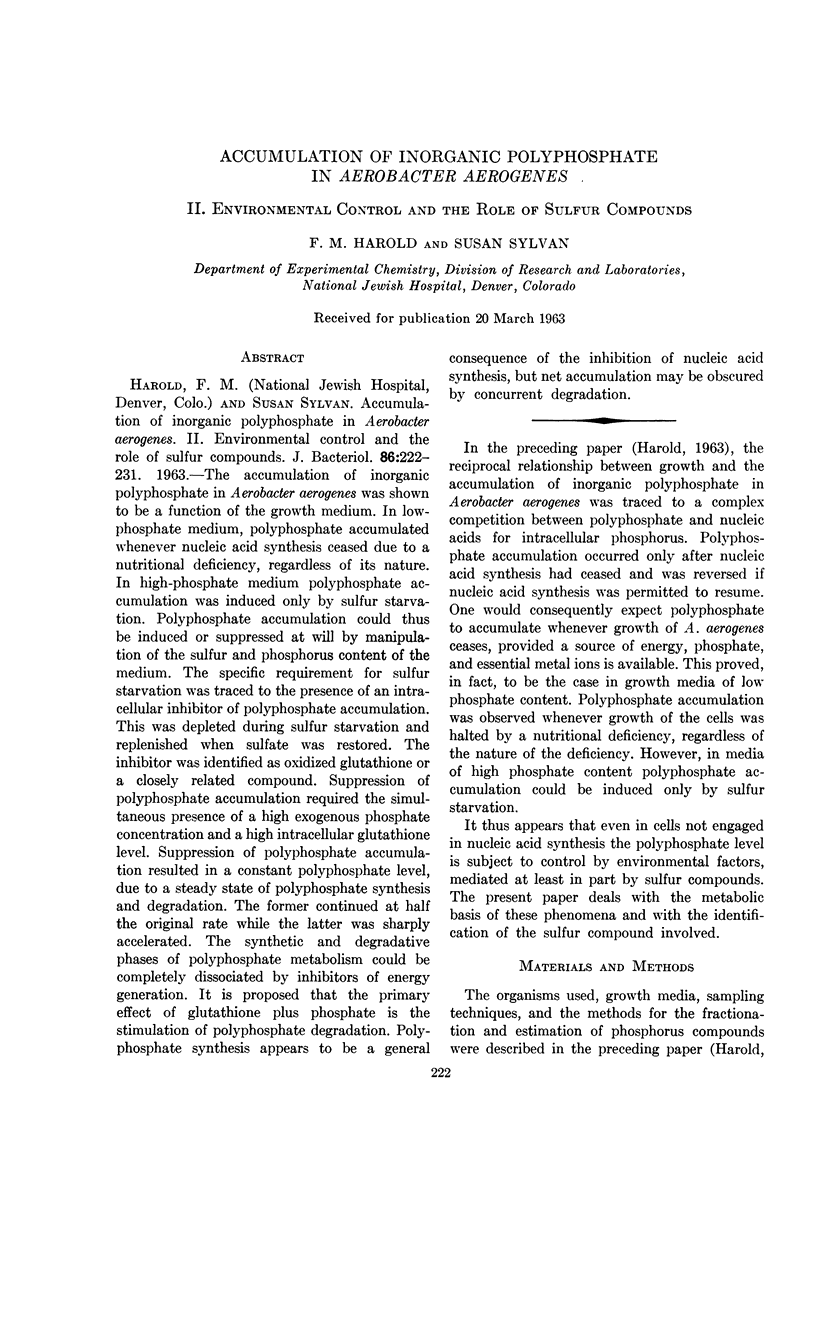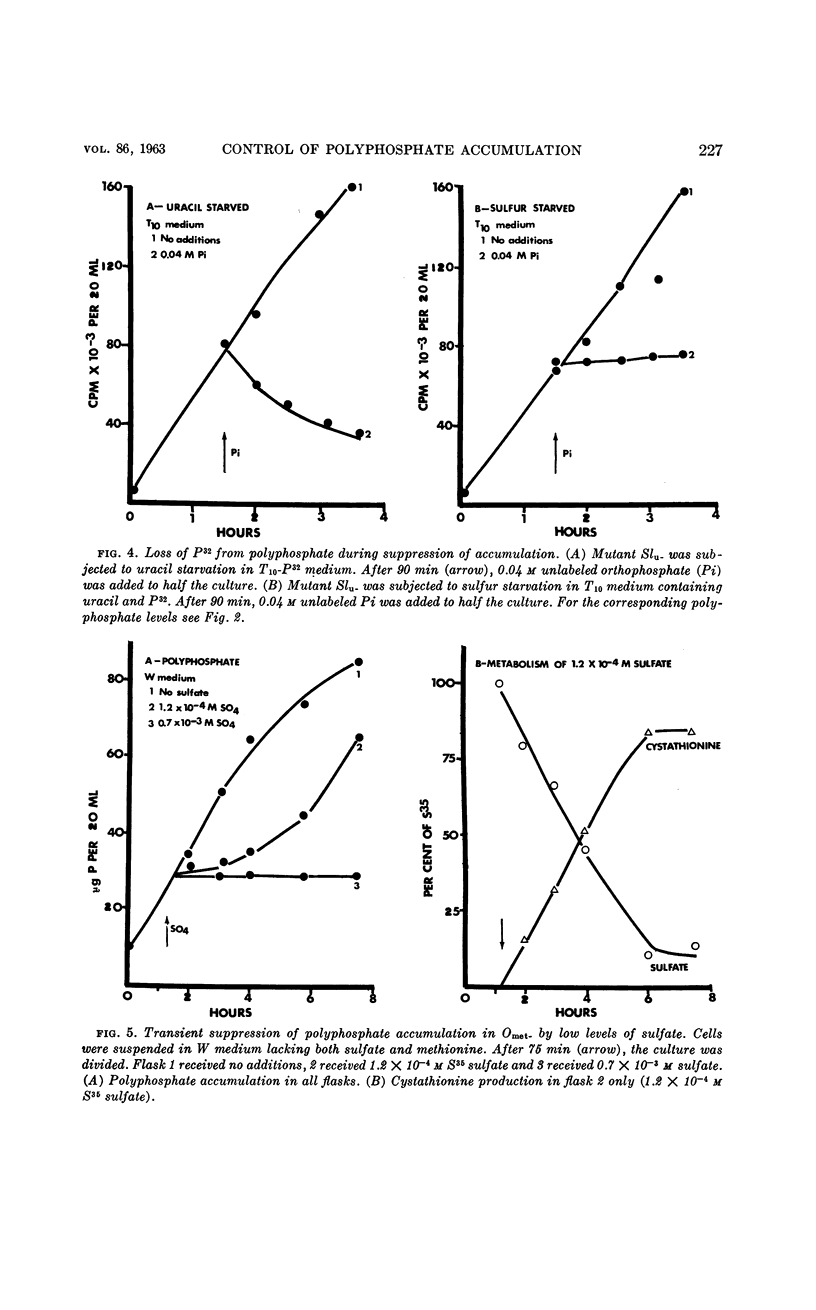Abstract
Harold, F. M. (National Jewish Hospital, Denver, Colo.) and Susan Sylvan. Accumulation of inorganic polyphosphate in Aerobacter aerogenes. II. Environmental control and the role of sulfur compounds. J. Bacteriol. 86:222–231. 1963.—The accumulation of inorganic polyphosphate in Aerobacter aerogenes was shown to be a function of the growth medium. In low-phosphate medium, polyphosphate accumulated whenever nucleic acid synthesis ceased due to a nutritional deficiency, regardless of its nature. In high-phosphate medium polyphosphate accumulation was induced only by sulfur starvation. Polyphosphate accumulation could thus be induced or suppressed at will by manipulation of the sulfur and phosphorus content of the medium. The specific requirement for sulfur starvation was traced to the presence of an intracellular inhibitor of polyphosphate accumulation. This was depleted during sulfur starvation and replenished when sulfate was restored. The inhibitor was identified as oxidized glutathione or a closely related compound. Suppression of polyphosphate accumulation required the simultaneous presence of a high exogenous phosphate concentration and a high intracellular glutathione level. Suppression of polyphosphate accumulation resulted in a constant polyphosphate level, due to a steady state of polyphosphate synthesis and degradation. The former continued at half the original rate while the latter was sharply accelerated. The synthetic and degradative phases of polyphosphate metabolism could be completely dissociated by inhibitors of energy generation. It is proposed that the primary effect of glutathione plus phosphate is the stimulation of polyphosphate degradation. Polyphosphate synthesis appears to be a general consequence of the inhibition of nucleic acid synthesis, but net accumulation may be obscured by concurrent degradation.
Full text
PDF









Selected References
These references are in PubMed. This may not be the complete list of references from this article.
- HAROLD F. M. ACCUMULATION OF INORGANIC POLYPHOSPHATE IN AEROBACTER AEROGENES. I. RELATIONSHIP TO GROWTH AND NUCLEIC ACID SYNTHESIS. J Bacteriol. 1963 Aug;86:216–221. doi: 10.1128/jb.86.2.216-221.1963. [DOI] [PMC free article] [PubMed] [Google Scholar]
- HAROLD F. M. Accumulation of cystathionine in a homocysteine requiring mutant of Aerobacter aerognes. J Bacteriol. 1962 Aug;84:382–383. doi: 10.1128/jb.84.2.382-383.1962. [DOI] [PMC free article] [PubMed] [Google Scholar]
- HAROLD F. M. Depletion and replenishment of the inorganic polyphosphate pool in Neurospora crassa. J Bacteriol. 1962 May;83:1047–1057. doi: 10.1128/jb.83.5.1047-1057.1962. [DOI] [PMC free article] [PubMed] [Google Scholar]
- HOTCHKISS R. D. The assimilation of amino acids by respiring washed Staphylococci. Arch Biochem Biophys. 1956 Nov;65(1):302–318. doi: 10.1016/0003-9861(56)90196-5. [DOI] [PubMed] [Google Scholar]
- KALTWASSER H. [The role of polyphosphate in phosphorus metabolism of an oxyhydrogen gas bacterium (Hydrogenomonas strain 20)]. Arch Mikrobiol. 1962;41:282–306. [PubMed] [Google Scholar]
- LISS E., LANGEN P. [Experiments on polyphosphate overcompensation in yeast cells after phosphate deficiency]. Arch Mikrobiol. 1962;41:383–392. [PubMed] [Google Scholar]
- PECK H. D., Jr Symposium on metabolism of inorganic compounds. V. Comparative metabolism of inorganic sulfur compounds in microorganisms. Bacteriol Rev. 1962 Mar;26:67–94. doi: 10.1128/br.26.1.67-94.1962. [DOI] [PMC free article] [PubMed] [Google Scholar]
- SMITH I. W., WILKINSON J. F., DUGUID J. P. Volutin production in Aerobacter aerogenes due to nutrient imbalance. J Bacteriol. 1954 Oct;68(4):450–463. doi: 10.1128/jb.68.4.450-463.1954. [DOI] [PMC free article] [PubMed] [Google Scholar]


